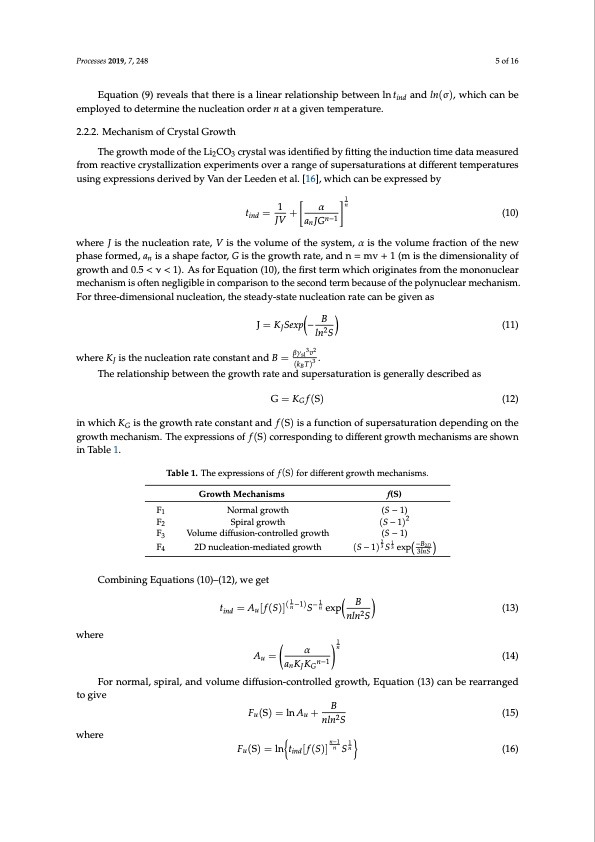
PDF Publication Title:
Text from PDF Page: 005
Processes 2019, 7, 248 5 of 16 Equation (9) reveals that there is a linear relationship between ln tind and ln(σ), which can be employed to determine the nucleation order n at a given temperature. 2.2.2. Mechanism of Crystal Growth The growth mode of the Li2CO3 crystal was identified by fitting the induction time data measured from reactive crystallization experiments over a range of supersaturations at different temperatures using expressions derived by Van der Leeden et al. [16], which can be expressed by 1 α n1 tind = JV + anJGn−1 (10) where J is the nucleation rate, V is the volume of the system, α is the volume fraction of the new phase formed, an is a shape factor, G is the growth rate, and n = mv + 1 (m is the dimensionality of growth and 0.5 < ν < 1). As for Equation (10), the first term which originates from the mononuclear mechanism is often negligible in comparison to the second term because of the polynuclear mechanism. For three-dimensional nucleation, the steady-state nucleation rate can be given as B J = KJSexp − 2 (11) ln S where K is the nucleation rate constant and B = βγsl3v2 . J (kBT)3 The relationship between the growth rate and supersaturation is generally described as G = KG f(S) (12) in which KG is the growth rate constant and f (S) is a function of supersaturation depending on the growth mechanism. The expressions of f (S) corresponding to different growth mechanisms are shown in Table 1. Table 1. The expressions of f (S) for different growth mechanisms. where α n1 Au = anKJKGn−1 f(S) (S − 1) (S − 1)2 (S − 1) (S−1)23S13 exp−B2D 3lnS Combining Equations (10)–(12), we get tind =Au[f(S)] n S n exp nln2S F1 F2 F3 F4 Growth Mechanisms Normal growth Spiral growth Volume diffusion-controlled growth 2Dnucleation-mediatedgrowth (1−1) −1 B (13) (14) For normal, spiral, and volume diffusion-controlled growth, Equation (13) can be rearranged to give where Fu(S)=lnAu+ B (15) nln2 S n−11 Fu(S) = ln tind[f(S)] n Sn (16)PDF Image | Reactive Crystallization Process of Lithium Carbonate

PDF Search Title:
Reactive Crystallization Process of Lithium CarbonateOriginal File Name Searched:
processes-07-00248-v2.pdfDIY PDF Search: Google It | Yahoo | Bing
Product and Development Focus for Infinity Turbine
ORC Waste Heat Turbine and ORC System Build Plans: All turbine plans are $10,000 each. This allows you to build a system and then consider licensing for production after you have completed and tested a unit.Redox Flow Battery Technology: With the advent of the new USA tax credits for producing and selling batteries ($35/kW) we are focussing on a simple flow battery using shipping containers as the modular electrolyte storage units with tax credits up to $140,000 per system. Our main focus is on the salt battery. This battery can be used for both thermal and electrical storage applications. We call it the Cogeneration Battery or Cogen Battery. One project is converting salt (brine) based water conditioners to simultaneously produce power. In addition, there are many opportunities to extract Lithium from brine (salt lakes, groundwater, and producer water).Salt water or brine are huge sources for lithium. Most of the worlds lithium is acquired from a brine source. It's even in seawater in a low concentration. Brine is also a byproduct of huge powerplants, which can now use that as an electrolyte and a huge flow battery (which allows storage at the source).We welcome any business and equipment inquiries, as well as licensing our turbines for manufacturing.| CONTACT TEL: 608-238-6001 Email: greg@infinityturbine.com | RSS | AMP |